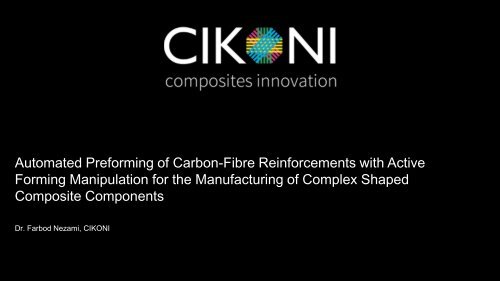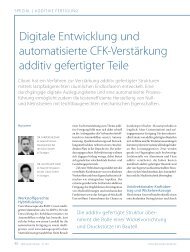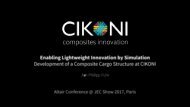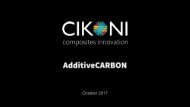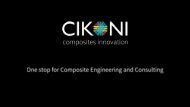Automated Preforming of Carbon-Fibre Reinforcements for Automotive Composite Components
Insights into the automated preforming of carbon fiber reinforcements for automotive components. Please visti www.cikoni.com for more information
Insights into the automated preforming of carbon fiber reinforcements for automotive components. Please visti www.cikoni.com for more information
You also want an ePaper? Increase the reach of your titles
YUMPU automatically turns print PDFs into web optimized ePapers that Google loves.
<strong>Automated</strong> <strong>Pre<strong>for</strong>ming</strong> <strong>of</strong> <strong>Carbon</strong>-<strong>Fibre</strong> <strong>Rein<strong>for</strong>cements</strong> with Active<br />
Forming Manipulation <strong>for</strong> the Manufacturing <strong>of</strong> Complex Shaped<br />
<strong>Composite</strong> <strong>Components</strong><br />
Dr. Farbod Nezami, CIKONI
Source: Airbus, Boeing, ETZ, Daimler<br />
<strong>Automotive</strong> <strong>Composite</strong> Forming:<br />
Reliable, fast, effective, but…<br />
Geometry<br />
Process<br />
• Complex shaped geometries<br />
• Small sectioned parts<br />
• Packaging- & design demands<br />
What to do about<br />
quality?<br />
• High lot size<br />
• Cost sensible<br />
Fast <strong>for</strong>ming<br />
processes<br />
How can we improve the quality <strong>of</strong> pre<strong>for</strong>ms with an holistic quality approach?<br />
1. Parts free <strong>of</strong> wrinkles and reduction <strong>of</strong> fiber distortions (“waviness”)<br />
2. Influencing <strong>of</strong> fiber orientation and shear angles
Resin Transfer Moulding (RTM):<br />
High Volume Manufacturing in the <strong>Automotive</strong> Industry<br />
Forming<br />
Mechanisms<br />
<strong>Fibre</strong> Movement<br />
Shearing<br />
Bending<br />
Layers Gliding<br />
Rein<strong>for</strong>cement<br />
Cutting &<br />
Stacking<br />
<strong>Pre<strong>for</strong>ming</strong> Infiltration Cutting<br />
Handling • Draping<br />
Handling Handling<br />
• Bonding <strong>of</strong><br />
Layers<br />
Source: Daimler AG, Krauss Maffei
Sources: www.mercedes-benz.de<br />
Quality Issues and Defects in Forming <strong>of</strong> Complex Geometries:<br />
Wrinkles and Fiber Waviness<br />
Fiber<br />
Waviness<br />
Complex double curved areas<br />
Wrinkles<br />
Fiber Waviness and wrinkles are the most occurring defects in composite <strong>for</strong>ming and cause high rejection rates
State <strong>of</strong> the Art (Selection) und Shortcomings:<br />
Forming Manipulation Systems during Draping<br />
Principle<br />
BMW AG, 2000 BMW AG, 2011 Daimler AG, 2001<br />
Segmented<br />
blank holders<br />
Spötzl, 2003<br />
Draw bead Vacuum fixation Pressure tube<br />
Ply specific?<br />
Method?<br />
Initiation <strong>of</strong><br />
tensile <strong>for</strong>ces<br />
Initiation <strong>of</strong><br />
tensile <strong>for</strong>ces<br />
Initiation <strong>of</strong><br />
tensile <strong>for</strong>ces<br />
Initiation <strong>of</strong><br />
tensile <strong>for</strong>ces<br />
• Use <strong>of</strong> clamping / tensile <strong>for</strong>ces / membrane tensions<br />
• No consideration <strong>of</strong> layered character <strong>of</strong> pre<strong>for</strong>ms yet<br />
Development Goals:<br />
1. Development <strong>of</strong> methods <strong>of</strong> application <strong>for</strong> <strong>for</strong>ming manipulation systems<br />
2. Implementation <strong>of</strong> methods in active, ply specific and localized <strong>for</strong>ming manipulation systems
Studies<br />
Fundamentals<br />
Approach: Increase <strong>of</strong> Forming Complexity<br />
From Fundamentals to an <strong>Automotive</strong> Application<br />
Forming behavior <strong>of</strong> single<br />
ply under tension<br />
Full scale automated pre<strong>for</strong>ming <strong>of</strong> automotive components<br />
Optimization <strong>of</strong> process<br />
parameters<br />
Characterization <strong>of</strong><br />
interactions<br />
T, t, F<br />
Which causal loops will lead to defects? Which measures are necessary?<br />
<strong>Pre<strong>for</strong>ming</strong> with increasing complexity<br />
Isolation <strong>of</strong> complex shape<br />
Trans<strong>for</strong>mation <strong>of</strong> methods<br />
Trans<strong>for</strong>mation <strong>of</strong> methods
Material characterization with process induced factors:<br />
Shear-Tension Coupling<br />
A<br />
B<br />
Membrane tension<br />
No wrinkles at 55°<br />
Tension free<br />
Wrinkles at 55°
Forming manipulation <strong>of</strong> woven fabrics:<br />
Possibilities and Limits<br />
1 2 3 4<br />
• Homogeneous membrane tensions will lead to symmetric draw-in <strong>of</strong> fabrics<br />
• Wrinkles can be suppressed efficiently<br />
• Asymmetric membrane tensions allow control <strong>of</strong> material draw in and influence <strong>of</strong> fiber orientation<br />
• Limited possible discretization due to fabric‘s architecture<br />
• Further possibilities are given by process controlled tensioning
Draping <strong>of</strong> Multilayer Pre<strong>for</strong>ms:<br />
Influence <strong>of</strong> ply orientation<br />
Multilayer without blank holders<br />
Single ply with blank holders<br />
• Relative displacements due to superposition <strong>of</strong> divergent local <strong>for</strong>ming mechanisms <strong>of</strong> fabrics will increase the risk <strong>of</strong> in-plane <strong>for</strong>ming<br />
defects<br />
• Despite same ply-orientation small radii increase friction and lead to interaction based <strong>for</strong>ming failures<br />
• Blank holders won‘t allow ply specific manipulation<br />
• Contrary demand <strong>for</strong> suppression <strong>of</strong> wrinkles and fiber distortions
Definition <strong>of</strong> a Forming Limit Diagram <strong>for</strong> Interaction Defects<br />
Acting <strong>for</strong>ces<br />
Integrity against damage<br />
• Damage is a complex interplay <strong>of</strong> structural integrity <strong>of</strong> rein<strong>for</strong>cement and acting <strong>for</strong>ces<br />
• A constellation-dependant damage diagram was derived <strong>for</strong> discription <strong>of</strong> in-plane damaging inition<br />
• Normal pressure is dominant driver <strong>of</strong> in-plane damage<br />
→ Reduction <strong>of</strong> normal <strong>for</strong>ces necessary
Recent developments in prediction <strong>of</strong> fiber waviness<br />
The first chapter <strong>of</strong> the approach showed us that:<br />
– There is an interlink between tension (process) and wrinkling (textile)<br />
– There is an interaction <strong>of</strong> layers towards each other which can cause fiber waviness<br />
– Both factors can be described by physical characterization experiments<br />
Fine, but what can we do in process development?
Decoupling <strong>of</strong> fabrics' interaction under blank holders:<br />
Passive interlayers to reduce friction between layers<br />
Decoupling <strong>of</strong> interaction under blank holders<br />
Opening<br />
Fabric<br />
Metallic interlayer<br />
Stacking<br />
Opening <strong>for</strong> male<br />
tools<br />
Geometry matched <strong>for</strong>ming manipulation (here <strong>for</strong> 0°)<br />
Direct interplay <strong>of</strong><br />
fiber orientation and<br />
damage initiation
Integration <strong>of</strong> piezo actuators <strong>for</strong> quality improvements:<br />
From passive to active manipulation "Tailored Drape"<br />
Blank holder utilization with metallic interlayer<br />
Material draw-in only controllable globally<br />
No discrete manipulation <strong>of</strong> single ply possible<br />
Limited manipulation <strong>of</strong> fiber orientation possible<br />
Demanding draping simulation due to variable friction coefficients<br />
Prevention <strong>of</strong> interaction based defects under blank holders<br />
Interaction based defects inside the cavity<br />
Taken measure: Integration <strong>of</strong> piezo bending actuators<br />
Piezo bending actuators<br />
Oscillations to reduce friction<br />
Tension initiation to eliminate wrinkles
Transfer <strong>of</strong> principle to active interlayers <strong>for</strong> friction reduction<br />
and ply specific tensioning<br />
Mechanical actuators<br />
Reduction <strong>of</strong> interaction <strong>for</strong>ce and fiber<br />
waviness by oscillations<br />
Reduction <strong>of</strong> wrinkling due to local application<br />
<strong>of</strong> tensile <strong>for</strong>ces
Active interlayers:<br />
Selection <strong>of</strong> effects on <strong>for</strong>ming quality<br />
Clamping with<br />
mechanical<br />
actuators<br />
Prevents wrinkles<br />
Manipulation <strong>of</strong> fiber orientation<br />
possible<br />
Ply-specific clamping achieved<br />
Higher clamping <strong>for</strong>ce<br />
necessary<br />
Draw-in<br />
Reference<br />
without interlayer<br />
„Tailored Drape“<br />
result<br />
Reduction <strong>of</strong> friction<br />
between plies<br />
by oscillations<br />
Damaged<br />
Improved Quality
Application: Mercedes-Benz AMG Backlid<br />
Transfer to<br />
active interlayers<br />
Multilayer draping with active<br />
interlayers<br />
Cut-out optimization and ply<br />
Orientation clamping0°<br />
Cut / Dart<br />
Clamping<br />
Clamping<br />
Piezo actuators<br />
<strong>for</strong> oscillations<br />
0/90° top layer<br />
•<br />
Homogenous<br />
Reduction<br />
Blank<br />
<strong>of</strong><br />
Holder<br />
the size<br />
Force<br />
<strong>of</strong><br />
wrinkles by 81,5%<br />
• Complete suppression<br />
<strong>of</strong> interaction based<br />
defects<br />
Orientation 45°<br />
Different material<br />
draw-in and<br />
clamping<br />
necessary!<br />
Ply-specific clamping
Process integration, challenges and benefits:<br />
Easy Automation and Fast Cycle Times<br />
Shown here: passive system<br />
without oscillations
Conclusions<br />
• To increase quality <strong>of</strong> parts being produced by composite <strong>for</strong>ming an holistic approach is necessary<br />
as interlinks <strong>of</strong> domains drive overall quality<br />
• Early stage material characterization can help to identify dominant quality drivers<br />
• In pre<strong>for</strong>ming it was found that wrinkles can be suppressed by local tensioning, but risk <strong>of</strong><br />
interaction defects like fiber waviness can increase hereby. There<strong>for</strong>e reduction <strong>of</strong> normal contact<br />
<strong>for</strong>ces is necessary.<br />
• This was realized by the utilization <strong>of</strong> active interlayers which can actively control tensioning and<br />
reduce interlayer friction by oscillations<br />
• The approach can be easily automated and it can be integrated into existing hydraulic presses<br />
• Automation <strong>for</strong> smaller lot sizes <strong>of</strong> up to 5000 parts/year shown as feasible


